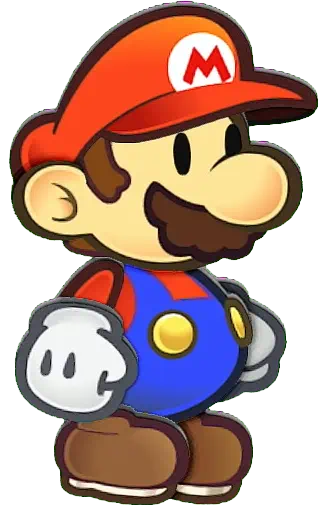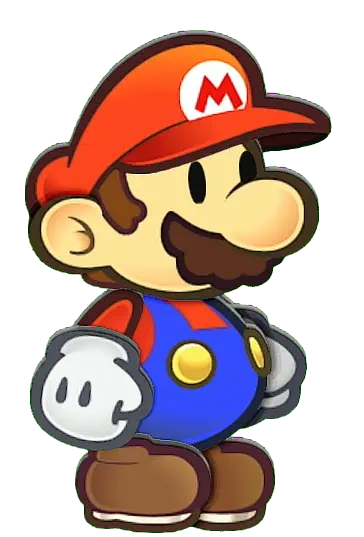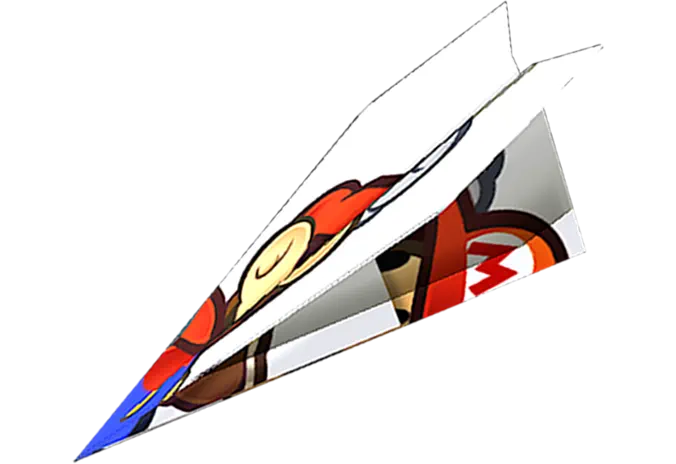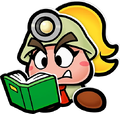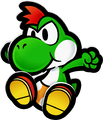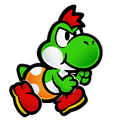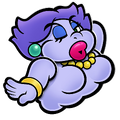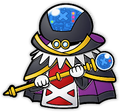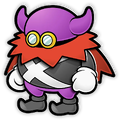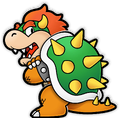Paper Mario: The Thousand-Year Door (Nintendo Switch): Difference between revisions
Ma-sansunsun (talk | contribs) |
(→Gallery: added PAL box art) Tag: Mobile edit |
||
| Line 136: | Line 136: | ||
<gallery> | <gallery> | ||
Paper Mario RPG JpSwitchcover.jpg|Pre-release Japanese box art | Paper Mario RPG JpSwitchcover.jpg|Pre-release Japanese box art | ||
TTYDswitchEUboxart.jpg|Pre-release European box art | |||
</gallery> | </gallery> | ||
Revision as of 07:22, March 11, 2024
This article is about an upcoming game. Editors must cite sources for all contributions to this article. Edits that do not follow this standard may be reverted without notice.
Do not upload any leaked images or media files before this game is released. Per our policy, any such files will be immediately deleted.
| Paper Mario: The Thousand-Year Door | |||||||||
|---|---|---|---|---|---|---|---|---|---|
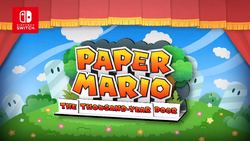 For alternate box art, see the game's gallery. | |||||||||
| Developer | Intelligent Systems[1] | ||||||||
| Publisher | Nintendo | ||||||||
| Platform(s) | Nintendo Switch | ||||||||
| Release date | May 23, 2024[?] | ||||||||
| Language(s) | English (United States) French (France) German Spanish (Spain) Italian Dutch Japanese Simplified Chinese Traditional Chinese Korean | ||||||||
| Genre | RPG | ||||||||
| Rating(s) |
| ||||||||
| Mode(s) | Single player | ||||||||
Paper Mario: The Thousand-Year Door is an upcoming Nintendo Switch remake of the 2004 Nintendo GameCube game of the same name, and the first remake in the Paper Mario series. It was first announced during the September 2023 Nintendo Direct, and it is set to be released on May 23, 2024.[2][3]
The title will feature visually enhanced and updated graphics. However, it remains faithful to the style of the original game: the characters still use their designs from the original release (notably, Princess Peach keeps her pre-Mario Party 4 dress design), rather than the updated designs used in the following Paper Mario games. Voice clips from the original game are also reused, in spite of voice actor changes since the original game's release, including Mario's voice actor Charles Martinet, who retired from voicing characters in the franchise in August 2023.
Differences
Gameplay changes
- During battles, there is an option on the bottom right corner of the screen known as "Tattle Check".[2]
Text changes and localization
- The game has now been translated to Chinese (Simplified and Traditional), Dutch, and Korean. The original was not available in these three languages, because at the time, Nintendo of Europe did not do Dutch localizations, and Nintendo of Hong Kong and Nintendo of Korea did not yet exist.
- TEC-XX now has a red eye in all regions rather than only in Japan.[2]
- The game's logo in international regions has been redesigned to resemble the Japanese logo of the original game more. Conversely, the Japanese logo is now primarily written in English, matching the design conventions of the series's Japanese logos from Super Paper Mario onward.
- There is a "SUPERGUARD" text pop-up that appears when the player successfully performs a Superguard. The original game displayed the standard "GREAT!" text instead.
- During the Bowser intermission levels, a list of controls for Bowser is now displayed in the bottom left corner of the screen.[2]
- Text is now vertically centered within text boxes; in the original game, text was aligned to the top of the box. Also, some text has been reformatted due to the higher screen resolution allowing for more text per line.[2]
- Some English character dialogue has been altered slightly from the original game. For example, in the original, when Mario enters the town square of Rogueport for the first time, Goombella states that she is merely a "Student at the University of Goom", while in the remake, she specifically states that she is a junior at the school. In another example, the insult Bowser uses to address Kammy Koopa is changed from "Airhead" to "Lunkhead" during his interlude after completing Chapter 1.[2]
- Some other dialogue in the script also seems to have been altered. For example, the line "To find the treasure of yore, take the seven Crystal Stars to the Thousand-Year Door" was said by Goombella in the original game, but in the remake, it is said by Professor Frankly instead.
- In the Italian version, the name of the University of Goom is changed to accommodate its rename in Paper Mario: Sticker Star.[4]
Graphical changes
- The entire game has a higher-resolution, more crafted appearance similar to recent entries starting from Paper Mario: Color Splash onward, though it keeps the original game's smoother animations, rather than the choppier animations seen in those entries. For example, the characters now have a slightly thicker paper texture similar to cardstock, while the pigs have visible seams on them, and coins are fully modeled rather than sprites.[2] To go alongside these changes, dynamic lighting is now present extensively in many areas.
- Characters are generally more expressive, such as during the kitchen mystery on the Excess Express.[2]
- The Mario Bros.' House has a group picture of Mario's partners from the first Paper Mario, as a call-forward to Super Paper Mario featuring said picture along with one for the partners from The Thousand-Year Door. The map inside the house has also been changed to the world map from Paper Mario, and the exterior of the bedroom was sectioned to match its design from that game.[2]
- When Rogueport appears for the first time when Peach's letter is being read in the opening cutscene, the letter itself is no longer visible below.
- A few new character designs have been added, such as a purple Toad in Glitzville dressed in a tangzhuang coat and a guapi mao cap.[2]
- The vine patterns on the ground in Boggly Woods now have an iridescent sheen than the gradient of colors used in the original game.
- The whole party is visible while riding the Cheep Blimp.[2]
- More characters can be seen from behind, such as Mario's partners, unlike in the original, where they are shown in a frontal profile regardless of the camera angle.[2]
- Due to the widescreen resolution, the HUD elements, transitions, and some interiors have been redesigned to accommodate the extra horizontal space. Framing in several cutscenes and some background scenery has also been readjusted to go alongside these changes.
- The character artwork in transitions is now shaded. The transitions themselves also go by much faster compared to the original game.
- More visual aids for points of interest have been implemented, such as a sign that displays an icon with tacked papers above the door to the Trouble Center building, the pipe leading to Petal Meadows now resting on a grassy platform, and a set of easily visible footprints in eastern Rogueport that leads into a hidden alley.[2]
- The area the black chest face resides is now a fully 3D environment, rather than being a static background. When a black chest face curses Mario, he gets struck by lightning, while in the original, the screen flashes white while Mario is cursed.[2]
- Pa-Patch's eyepatch now always appears over his left eye, while in the original, it would appear on the right eye if he was facing right.[2]
- Bowser now has a rainbow effect instead of flashing yellow when becoming gigantic in his levels.[2]
Audio changes
- The game's music has been rearranged with new instrumentation, and now sounds similar to later entries in the Paper Mario series.[2]
- Characters are given unique talking sounds during dialogue, similar to the Mario & Luigi series, and Paper Mario series entries from Sticker Star onward. Luigi and Princess Peach, for example, have talking sounds similar to their voices, while Koops has talking sound identical to modern Koopa Troopa vocal effects.[2]
- When Mario stands on top of the plane panel, a sound effect reminiscent of Magic Circles from Paper Mario: The Origami King can be heard.[5]
- There is a sound effect when Mario uses Paper Mode between two walls.[5]
- The sound effect when an enemy is defeated is reminiscent of the sound from Paper Mario: Sticker Star.[6]
Miscellaneous
- The game's European and Japanese age ratings have been raised to PEGI 7 and CERO B, up from PEGI 3 and CERO A of the original game, respectively.
Gallery
Logos
- PMTTYD NS Logo.jpg
English logo
- PMTTYD NS Logo French.jpg
French logo
- PMTTYD NS Logo German.jpg
German logo
- PMTTYD NS Logo Italian.jpg
Italian logo
- PMTTYD NS Logo Spanish.jpg
Spanish logo
Artwork
Characters
Mario (Plane Mode)
Key artwork
Screenshots
Parakarry arriving at Mario's House during the prologue
Mario and Goombella encountering a Goomba in Petal Meadows
Mario and Goombella in battle against five Goombas
Mario and Koops encountering Ms. Mowz
Mario in Plane Mode at Hooktail Castle
Mario and Goombella in Boggly Woods
Mario and his partners in the blimp to Glitzville
Mario using Mini-Yoshi in East Rogueport
Mario and Goombella in the Creepy Steeple
Mario and Koops in the Rogueport Sewers
Mario and Mini-Yoshi in Keelhaul Key
Mario and Goombella in Riverside Station
The Excess Express
Mario and Flurrie in Twilight Town
Mario and Goombella in the 65th Super Fun Quirk Quiz
Mario and Koops in Podley's Place
Box art
- Paper Mario RPG JpSwitchcover.jpg
Pre-release Japanese box art
- TTYDswitchEUboxart.jpg
Pre-release European box art
References to other media
- Super Nintendo Entertainment System: The colors of the button icons in combat correspond to those of the Japanese and PAL controller buttons.[2]
- Paper Mario: The world map from this game appears on a wall in the Mario Bros.' House. An arranged version of this game's title screen theme plays in the reveal trailer.[2]
- Super Paper Mario: The Mario Bros.' House now has the same picture of Mario's partners from Paper Mario as seen in this game.[2]
Names in other languages
| Language | Name | Meaning | Notes |
|---|---|---|---|
| Japanese | ペーパーマリオRPG[?] Pēpā Mario Āru Pī Jī |
Paper Mario RPG This naming method is similar to Super Mario RPG and the Japanese name of Mario & Luigi: Superstar Saga. |
|
| Chinese (simplified) | 纸片马力欧RPG[?] Zhǐpiàn Mǎlì'ōu RPG |
Paper Mario RPG | |
| Chinese (traditional) | 紙片瑪利歐RPG[7] Zhǐpiàn Mǎlì'ōu RPG |
Paper Mario RPG | |
| Dutch | Paper Mario: The Thousand-Year Door[?] | - | |
| French (NOA) | Paper Mario: The Thousand-Year Door[?] | - | |
| French (NOE) | Paper Mario: La Porte Millénaire[?] | Paper Mario: The Millennium Door | |
| German | Paper Mario: Die Legende vom Äonentor[?] | Paper Mario: The Legend of the Aeon Gate | |
| Italian | Paper Mario: Il Portale Millenario[?] | Paper Mario: The Millennium Portal | |
| Korean | 페이퍼 마리오 1000년의 문[?] Peipeo Malio Cheon-nyeon-ui Mun |
Paper Mario: The Thousand-Year Door | |
| Portuguese | Paper Mario: The Thousand-Year Door[?] | - | |
| Spanish (NOA) | Paper Mario: The Thousand-Year Door[?] | - | |
| Spanish (NOE) | Paper Mario: La Puerta Milenaria[?] | Paper Mario: The Millennium Door |
External links
- Official North American game page
- Official Canadian (French) game page
- Official Latin American game page
- Official Brazilian game page
- Official Japanese game page
- Official United Kingdom game page
- Official Belgium (Dutch) game page
- Official Belgium (French) game page
- Official German game page
- Official España game page
- Official French game page
- Official Italian game page
- Official Dutch game page
- Official Austrian game page
- Official Portuguese game page
- Official Swiss (German) game page
- Official Swiss (French) game page
- Official Swiss (Italian) game page
- Official South African game page
- Official Australian game page
References
- ^ Nintendo UK Store page Screenshot
- ^ a b c d e f g h i j k l m n o p q r s t u Nintendo of America (September 14, 2023). Nintendo Direct 9.14.2023 - Nintendo Switch. YouTube. Retrieved September 14, 2023.
- ^ Nintendo of America (10th March 2024). ICYMI: #PaperMario: The Thousand-Year Door arrives on #NintendoSwitch May 23rd! #PaperMarioTheThousandYearDoor. Twitter. Retrieved 10th March 2024.
- ^ Paper Mario: Il Portale Millenario arriva su Nintendo Switch nel 2024!; NintendoItalia on YouTube. Retrieved on September 14, 2023
- ^ a b https://topics.nintendo.co.jp/article/aa63dd30-4bb8-4f17-83b9-a39e1d985fde
- ^ https://youtu.be/re-3JIatUTw
- ^ (September 14, 2023). 《紙片瑪利歐RPG》的最新資訊公開!本作預定於2024年發售。 Nintendo HK. Retrieved September 14, 2023.




